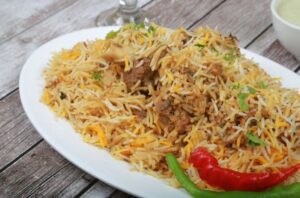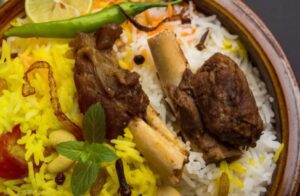Mutton Biryani, a masterpiece of aromatic spices and tender meat, has long been celebrated as a culinary gem across various cultures. This Eid, embrace the flavors of this delectable dish and embark on a gastronomic adventure that transcends boundaries.
In this article, we will delve into the history and origin of Mutton Biryani, provide you with an authentic recipe, shed light on its calorie content, and share valuable tips and tricks to help you master the art of creating an unforgettable Mutton Biryani.
Mutton Biryani History & Origin:
Mutton Biryani, a beloved dish enjoyed by many, has a fascinating history and origin that can be traced back to the royal kitchens of the Mughal Empire in the Indian subcontinent. The Mughals, who ruled over the region from the 16th to the 19th century, had a significant influence on the culinary traditions of India.

The roots of Mutton Biryani can be found in the Persian dish called “biryan,” which means fried or roasted. The Mughal emperors, who were of Turkic-Persian origin, sought to blend Persian and Indian cooking styles, resulting in the creation of a unique and flavorful dish known as Biryani.
The Mughals were known for their extravagant feasts and lavish lifestyles, and Biryani became an integral part of their culinary repertoire. It was considered a royal delicacy, reserved for special occasions and celebrations.
The dish was prepared using fragrant spices, tender meat (often mutton or chicken), and aromatic rice, creating a symphony of flavors that delighted the senses.
Over time, as the Mughal Empire expanded its influence, Biryani spread to different regions of the Indian subcontinent, adapting to the local tastes and culinary traditions.
Each region added its own distinct touch, resulting in a myriad of regional variations such as Hyderabadi Biryani, Lucknowi Biryani, Kolkata Biryani, and more.
Today, Mutton Biryani continues to be a symbol of indulgence and celebration, gracing the tables during festive occasions, weddings, and family gatherings.
Its rich history and royal heritage have made it a beloved dish not only in India but also in various parts of the world, where it is celebrated for its complex flavors and aromatic appeal.
The art of preparing Mutton Biryani has been passed down through generations, with families and chefs adding their own secrets and techniques to perfect this timeless dish.
It remains a testament to the rich culinary traditions that have shaped the Indian subcontinent, embodying the fusion of cultures and the harmonious blend of flavors that make it a culinary masterpiece.
Mutton Biryani Recipe:
Mutton Biryani is a dish that requires patience, skill, and a delicate balance of spices. While there are many variations of this delectable dish, the following recipe provides a traditional approach to preparing Mutton Biryani.

Mutton Biryani Ingredients:
- 500 grams mutton, cut into pieces
- 2 cups basmati rice
- 1 large onion, thinly sliced
- 2 tomatoes, chopped
- 1/2 cup plain yogurt
- 3 tablespoons ghee (clarified butter)
- 2 tablespoons oil (Use Cold Pressed Oils)
- 2 teaspoons ginger-garlic paste
- 2 teaspoons Biryani masala powder
- 1 teaspoon red chili powder (Use Mathania Chilli Powder)
- 1/2 teaspoon turmeric powder
- 1 teaspoon cumin seeds
- 4 green cardamom pods
- 4 cloves
- 2-inch cinnamon stick
- 2 bay leaves
- A handful of fresh mint leaves
- A handful of fresh coriander leaves
- Saffron strands, soaked in 2 tablespoons of warm milk (optional)
- Salt to taste
- Water
Marination:
- In a large bowl, combine the mutton pieces with yogurt, ginger-garlic paste, Biryani masala powder, red chili powder, turmeric powder, and salt. Mix well to coat the mutton evenly. Allow it to marinate for at least 1 hour, or preferably overnight in the refrigerator for enhanced flavors.
Rice Preparation:
- Rinse the basmati rice under running water until the water runs clear. Soak the rice in water for 30 minutes, then drain.
- In a large pot, bring water to a boil. Add salt, cumin seeds, green cardamom pods, cloves, cinnamon stick, and bay leaves. Add the soaked and drained rice. Cook the rice until it is 70% cooked, as it will continue to cook during the dum process. Drain the rice and set it aside.
Cooking the Mutton:
- Heat ghee and oil in a heavy-bottomed pan or a deep cooking pot. Add the sliced onions and sauté until golden brown. Remove half of the fried onions and set them aside for garnishing.
- Add the marinated mutton to the remaining onions in the pan. Cook the mutton on medium heat until it is browned and cooked through. This may take approximately 20 minutes. Stir occasionally to prevent sticking and ensure even cooking.
Layering and Dum Cooking:
- Reduce the heat to low. Layer the partially cooked rice evenly over the cooked mutton in the pan. Sprinkle the chopped tomatoes, mint leaves, and coriander leaves on top.
- Drizzle the saffron-infused milk over the rice for a vibrant color and added aroma (optional). Cover the pan with a tight-fitting lid or seal it with aluminum foil to trap the steam.
- Cook the biryani on low heat for about 25-30 minutes, allowing the flavors to meld together and the rice to cook through. This slow cooking process, known as dum cooking, ensures that the mutton becomes tender and the rice absorbs the aromatic essence.
- Once the biryani is cooked, gently fluff the rice with a fork, mixing the layers. Garnish with the reserved fried onions. Your flavorful Mutton Biryani is now ready to be served!
Serve the Mutton Biryani hot with raita (yogurt sauce), salad, or a side of mirchi ka salan (spicy chili gravy) for a complete and satisfying meal. Enjoy the burst of flavors and the tender mutton that will surely delight your taste buds.
Mutton Biryani Calories:
The calorie content of Mutton Biryani can vary based on the ingredients used and the portion size. Here’s a general breakdown of the approximate calorie content for one serving (around 250 grams) of Mutton Biryani:

- Mutton: Approximately 200-250 calories, depending on the cut and fat content.
- Basmati Rice: Around 150-200 calories, considering the quantity used.
- Ghee: Approximately 50-60 calories, depending on the amount added.
- Oil: Around 60-80 calories, depending on the quantity used.
- Yogurt: Approximately 40-50 calories, depending on the fat content.
- Onions, Tomatoes, and Spices: Negligible calorie contribution.
- Garnishes (Mint leaves, coriander leaves, fried onions): Negligible calorie contribution, as they are used in small quantities for flavor and presentation.
- Saffron-infused milk (optional): Negligible calorie contribution, as the amount used is minimal.
Overall, one serving of Mutton Biryani may contain approximately 450-550 calories. It’s important to note that these calorie estimates are approximate and can vary based on the specific ingredients and cooking methods used.
Mutton Biryani Tips & Tricks:
Preparing Mutton Biryani requires attention to detail and a few expert tips and tricks to elevate the flavors and ensure a delicious outcome. Here are some valuable tips to keep in mind:

- Quality Ingredients: Select high-quality mutton, preferably with a good balance of lean meat and fat, to ensure a flavorful and tender result. Choose fragrant basmati rice, as it adds a distinct aroma to the biryani.
- Marination is Key: Allow the mutton to marinate for at least 1 hour, or preferably overnight, in a mixture of yogurt and spices. This helps tenderize the meat and infuse it with flavors.
- Parboil the Rice: When cooking the rice, parboil it until it is about 70% cooked. This ensures that the rice remains fluffy and separate during the dum cooking process, preventing it from turning mushy.
- Layering Technique: When layering the partially cooked rice and mutton, ensure an even distribution of both. This helps create a harmonious blend of flavors throughout the dish.
- Dum Cooking: The key to achieving tender meat and aromatic rice is the dum cooking method. Seal the pan with a tight-fitting lid or aluminum foil to trap the steam and flavors. Cook the biryani on low heat to allow the ingredients to cook slowly and the flavors to meld together.
- Resting Period: Once the biryani is cooked, allow it to rest for a few minutes before serving. This helps the flavors to further develop and settle.
- Garnishing: The final touch of garnishing with fried onions, fresh mint leaves, and coriander leaves adds an enticing aroma and visual appeal to the dish. It’s worth taking the extra step to garnish the biryani before serving.
- Accompaniments: Serve the Mutton Biryani with raita (yogurt sauce), salad, or a side of mirchi ka salan (spicy chili gravy) to balance the flavors and enhance the overall dining experience.
Remember, practice makes perfect when it comes to mastering the art of Mutton Biryani. Adjust the spices and cooking time according to your taste preferences, and don’t be afraid to experiment with additional ingredients or techniques to make it your own signature dish.
Enjoy the process and savor the delightful flavors of this classic delicacy!
Conclusion:
Mutton Biryani is not just a dish; it is an exquisite amalgamation of history, culture, and tantalizing flavors. From its regal origins to its enchanting aroma and indulgent taste, Mutton Biryani has captured the hearts and taste buds of food enthusiasts worldwide.
With our comprehensive recipe, knowledge of its calorie content, and invaluable tips and tricks, you are now equipped to create your own culinary masterpiece that will leave your loved ones craving for more.
So, dive into the world of Mutton Biryani and savor the richness it brings to your festive celebrations!

